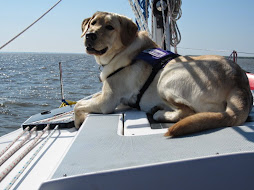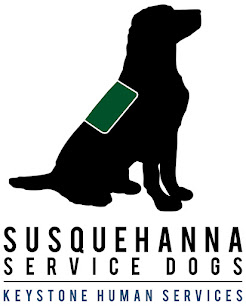Training tip from
Nancy Fierer, SSD’s founder and director
In October, I wrote about Fear and Keeping Your Dog Safe,
and I would like to revisit it because I consider it so important.
Our dogs look to us for support and consistency. At
Susquehanna Service Dogs, we do this through clear clicker training techniques
and consistent rules and expectations in the home, as well as by providing
love, food, and shelter. I know we all do these things (or strive to) and our
dogs count on us for it.
But there is more to keeping your dog safe. When you’re out
and about in the world with your dog in training or even with your pet—no matter
where you go—you encounter many situations that can be stressful, cause fear,
or actually be physically harmful for the dog.
For example, we all watch where we’re walking and if we see
broken glass or a dangerous surface, we make sure our dog avoids the area. This
may mean we don’t enter, we pick up our pup, or we take a detour. If we miss
seeing the broken glass, the dog is at risk of getting cut. Will the dog always
be cut, need a vet visit, or have permanent damage as a result? You all know
the answer. Mostly likely no, but once in a while, yes.
Like with the broken glass on the ground, we need to
recognize when to take action to keep our dogs safe and how exactly to do that.
There are two things to keep an eye out for:
·
Fear of other dogs and animals
·
Newly developed fear or an object or situation
I’m only going to cover fear of other dogs and animals here,
because I’ve already covered newly developed fears in a previous post,
but here are a few extra tips. Consider going to potentially scary places for
just a few minutes or looking at it from a distance. A good example is
fireworks. Distance and short duration are key here. For example, don’t go
downtown Harrisburg on the 4th of July with your pup to sit by the
river and watch the fireworks. Prepare for success by looking for possible
failure, stressors, and “danger.”
Your dog could show signs of fear around any other dog.
These could be dogs in your home, from puppy class, from your neighborhood, or
strange dogs. When this happens, do not allow on-leash greetings or
unsupervised play, especially in smaller enclosures, and don’t allow dominant
behavior, whether it’s your dog or the other dog. Remove your dog immediately
and then think about the situation. Sometimes, everyone was just too excited
and when all are calm, play can resume. However, if there was any fear on the
part of your dog, don’t let the dogs play together again.
Ultimately, when a dog is fearful of a situation, it has two
options—fight or flight. If the dog cannot leave (flight), then the only option
they’re left with is fight. Do I mean a dog fight? Sometimes that may happen,
but more likely, the dog will give a warning that any smart, confident dog will
listen to. Your dog may resort to growling, snapping, or a hard stare. Each
time your dog successfully deters the other dog, your dog is rewarded for its “aggressive”
behavior. If your dog actually barks or snarls significantly, adrenaline is
released, and this good feeling is a strong reinforcer that has a huge impact
on your dog’s future behavior. It creates a strong reinforcement history and
then next time, the dog may choose to use this aggressive, inappropriate
behavior sooner. This behavior can easily become generalized and then it becomes
a problem.
Don’t try to fix aggressive behavior. Simply avoid it. Keep
the dog from practicing the behavior because you don’t want to make it
stronger. If you have an SSD dog, this is the perfect time to ask the trainers
for help, because you can reverse a little problem before it turns into a big
one.
This is all part of keeping your dog safe. Remember, your
dog is being fearful when they’re acting aggressively and wants to be safe.









No comments:
Post a Comment